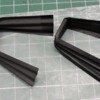DISCLAIMER: I am not breaking substantial new ground here, but this post might be helpful to those who have never tried this before
I decided to embark on a campaign to upgrade the ends of my fleet of Golden Gate Depot Passenger cars. So far I have completed two. As I have 30+ cars, and I don’t plan on doing this non-stop, I expect this to take awhile
Here are two cars, one before (left) and one after:
I added the following
- Scale City (ex Keil Line) diaphragms
- Precision Scale (PSC) Air hoses
- Precision Scale BARCO steam connectors
- Cut levers
- PRR style “bulls eye” marker lights (only to the end cars on each train)
This work goes much easier if you separate the ends from the cars. Fortunately its quite easy. Just remove the two screws just to the left of the coupler box:
The ends are registered by pins that go into the bottom lip of the roof. So, when the screws are out, just pull the end up and rotate the bottom it slightly outward
To install the diaphragms, I pretty much followed the instructions. Which, I trust Marty won’t mind, if I post them here
I needed to modify the striker plate and threshold casting to fit the GGD P70s.
The upper part of the striker plate was cut flat and the corners rounded in order to make them more Pennsy like.
The lower cross bar of the of the striker was made thinner to clear the Kadee coupler box. This necessitates making the threshold casting shorter. I cut out a section with a UMM UMM P100 saw. I have discussed these in an earlier post. These are very thin, very fine teeth saws that cut remarkably straight and fast. They look like this:
You can get them from UMM-USA:
http://umm-usa.com/onlinestore...o.php?products_id=35
Use soap as a lubricant every few passes.
Note I scuffed the plate for better paint/glue adhesion. Here is the back side of the striker plate with the threshold held in place with Goo and Zap-A-Gap thick CA. (apply the Goo to both surfaces, wait two minutes, apply drops of the CA to one surface, then press the pieces together.)
I assembled the support bars to the threshold plate per the instructions. So they look like this:
A word of caution: the section of the support bars which has the cast in thread is weak, and can’t take too many bends before it breaks. So don’t keep trying to straighten it. Live with it crooked until the final installation. (If you do break it, it can be repaired with a drop of Zap-A-Gap at the ends, apply accelerator, and then apply a sheath of JB Kwik Weld around the joint. But now, of course that exquisite thread detail is lost)
I then painted the assembly with Rustoleum Dark Gray Primer followed with mist coats of Rustoleum Weathered Wood. I painted the diaphragms with the same combination; Dark gray primer but with a heavier coat of weathered wood.
The painted one is on the left (DUH!)
The instructions recommend GOO to attach the diaphragms. I used adhesive transfer tape (Chooch #8249 is one of many brands) because it’s far less messy, and can be easily removed if needed. It’s basically an ultra thin, very strong two sided tape. I attach the diaphragm first to the striker (not shown) and then to the car end:
Ignore the fact that the tape on one leg is white, the other two yellow. The removable paper is different on the two sides of the sheet.
Here it is attached to the car. For clarity I did not paint the support rod/striker plate/threshold assembly prior to assembly on this one.
I decided not to add the leaf spring on top of the diaphragm. Scale City offers a very nice casting, but it is non functional, and hence would compromise operation around curves. I tried a thin piece of brass to simulate the spring, like Precision Scale or Pac Limited does, but I could not get it to both look realistic and allow smooth operation. Basically it prevents the diaphragm from compressing uniformly in curves. Besides, its tough to attach to the striker in the confined space above the “Pennsy-zed” striker. So no upper spring
The PSC air hoses, BARCO steam lines, and ersatz cut lever were attached by drilling holes on the underside of the end. The cut lever is made from .020” phosphor bronze (available from Tichy Train Group) and is held in place with PSC eye bolts.
The PRR Bulls Eye marker lights are made from Tower LEDs, and their construction is described in detail in an earlier post:
https://ogrforum.ogaugerr.com/...s-on-ggd-p70-coaches
Of course, the two big questions are
1) How much do these close the gap,
2) How much do these compromise operation.
The answers are
1): Completely. My O Scale passengers no longer have to do the flying broad jump to get between cars
2): Not at all. These cars go around the same 44” radius curves they always did. They would probably go around something tighter.
The learning curve here was rather shallow, and if I went into batch mode (two cars at a time) I estimate it would take three hours to do two cars. Excluding the lit markers, which are only going on end cars.
And of course, they do look better:


































